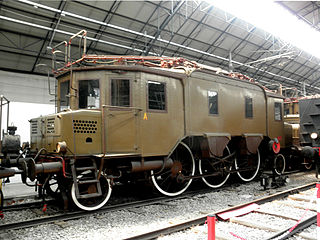
The Italian railway system is one of the most important parts of the infrastructure of Italy, with a total length of 24,227 km (15,054 mi).

Ferrovie Nord Milano is an Italian public transport company: the second largest railway company in Italy. It operates primarily in the northern Italian regions of Lombardy and Piedmont and in Canton Ticino in southern Switzerland. Listed on the Borsa Italiana, its main shareholders are the Lombardy Region (57.57%), Ferrovie dello Stato (14.5%) and Aurelia S.p.A. (3%).

A Krauss-Helmholtz bogie (Krauss-Helmholtz-Lenkgestell) is a mechanism used on steam locomotives and some electric locomotives to improve curve running.

The Brenner Railway is a major line connecting the Austrian and Italian railways from Innsbruck to Verona, climbing up the Wipptal, passing over the Brenner Pass, descending down the Eisacktal to Bolzano/Bozen, then further down the Adige Valley to Roverto/Rofreit, and along the section of the Adige Valley, called in Italian the “Vallagarina”, to Verona. This railway line is part of the Line 1 of Trans-European Transport Networks (TEN-T). It is considered a "fundamental" line by the state railways Ferrovie dello Stato (FS).
The William Dean 7 or Armstrong Class refers to a group of four prototype 4-4-0 double-frame locomotives built at the Swindon Works of the Great Western Railway in 1894.
FERROVIENORD S.p.A. is an Italian transport company, part of the FNM Group, that manages the network of regional railway concessions owned by the group in northern Italy.

The FS Class E.330 was a small class of three-phase electric locomotive used in Italy, introduced in the 1910s.

The Menaggio–Porlezza railway was a railway in the Italian province of Como. The line connected the town of Menaggio, on Lake Como, with Porlezza, on Lake Lugano, and was built as part of a multi-modal transport link between Menaggio and Luino, on Lake Maggiore.
Most Slovenian railway lines were built during the Austro-Hungarian Empire.

The Ferrovie dello Stato Italiane Class 600, formerly Rete Adriatica Class 380 and Società per le Strade Ferrate Meridionali Class 380, is a 2-6-0 'Mogul' steam locomotive; it is considered by some as the first Italian modern steam locomotive.
Giuseppe Zara was an Italian inventor. He was a member of the Società Italiana per le Strade Ferrate Meridionali, and the director of Ferrovie dello Stato from 1905.

Società Nazionale Officine di Savigliano (SNOS), also known as Savigliano, was one of the most prestigious Italian industrial companies of the twentieth century. It had interests in many sectors including mechanical and electrical engineering. It was founded in Turin on 17 July 1880, with a share capital of one million lire, with the aim of undertaking the "construction and repair of railway material, metal bridges, canopies, mechanical, electrical and aeronautical constructions as well as woodworking. generally".

FS Class 113 was a class of 0-4-2 steam locomotives of the Ferrovie dello Stato (FS), inherited from older railway companies on the nationalization of Italian railways in 1905. They were built by Gio. Ansaldo & C. between 1854 and 1869.

The Mastodonte dei Giovi was a special double steam locomotive built specifically for use on the difficult Apennine stretch of the new Turin - Genoa railway line, inaugurated in 1853.
Locomotives SFAI 301-311 of the Società per le strade ferrate dell'Alta Italia (SFAI) were a group of steam locomotives derived from the rebuilding of some machines in the 31-80 series.
Locomotive SFAI 1400 was a small 0-4-0 tank locomotive built in 1870 for the Società per le strade ferrate dell'Alta Italia (SFAI) by Cockerill of Seraing.
Locomotives SFM 1-34 refers to a class of 2-2-2 steam locomotives of the Società Italiana per le Strade Ferrate Meridionali (SFM). They were designed for hauling fast passenger trains.
















